sensor TOYOTA VERSO 2014 Owner's Manual
[x] Cancel search | Manufacturer: TOYOTA, Model Year: 2014, Model line: VERSO, Model: TOYOTA VERSO 2014Pages: 650, PDF Size: 36.61 MB
Page 263 of 650

263 2-3. Operating the lights and wipers
2
When driving
Vehicles with smart entry & start system:
If the wiper switch is turned to the position while the “ENGINE
START STOP” switch is in IGNITION ON mode, the wiper will operate
once to show that AUTO mode is activated.
If the wiper sensitivity is adjusted to higher, the wiper may operate once to
indicate the change of sensitivity.
If the temperature of the raindrop sensor is 85°C (185°F) or higher, or
-40°C (-40°F) or lower, automatic operation may not occur. In this case,
operate the wipers in any mode other than AUTO.
If no windshield washer fluid sprays
Check that the washer nozzles are not blocked and if there is washer fluid in
the windshield washer fluid reservoir.
CAUTION
Caution regarding the use of windshield wipers in AUTO mode
The windshield wipers may operate unexpectedly if the sensor is touched or
the windshield is subject to vibration in AUTO mode. Take care that your fin-
gers or anything else do not become caught in the windshield wipers.
Caution regarding the use of washer fluid
When it is cold, do not use the washer fluid until the windshield becomes
warm. The fluid may freeze on the windshield and cause low visibility. This
may lead to an accident, resulting in death or serious injury.
NOTICE
When the windshield is dry
Do not use the wipers, as they may damage the windshield.
When the washer fluid tank is empty
Do not use the washer when the washer fluid tank is empty. This may cause
the washer fluid pump to overheat.
When there is no windshield washer fluid spray from the nozzle
Damage to the washer fluid pump may be caused if the lever is pulled
toward you and held continually.
VERSO_WE.book Page 263 Thursday, June 19, 2014 11:31 AM
Page 272 of 650
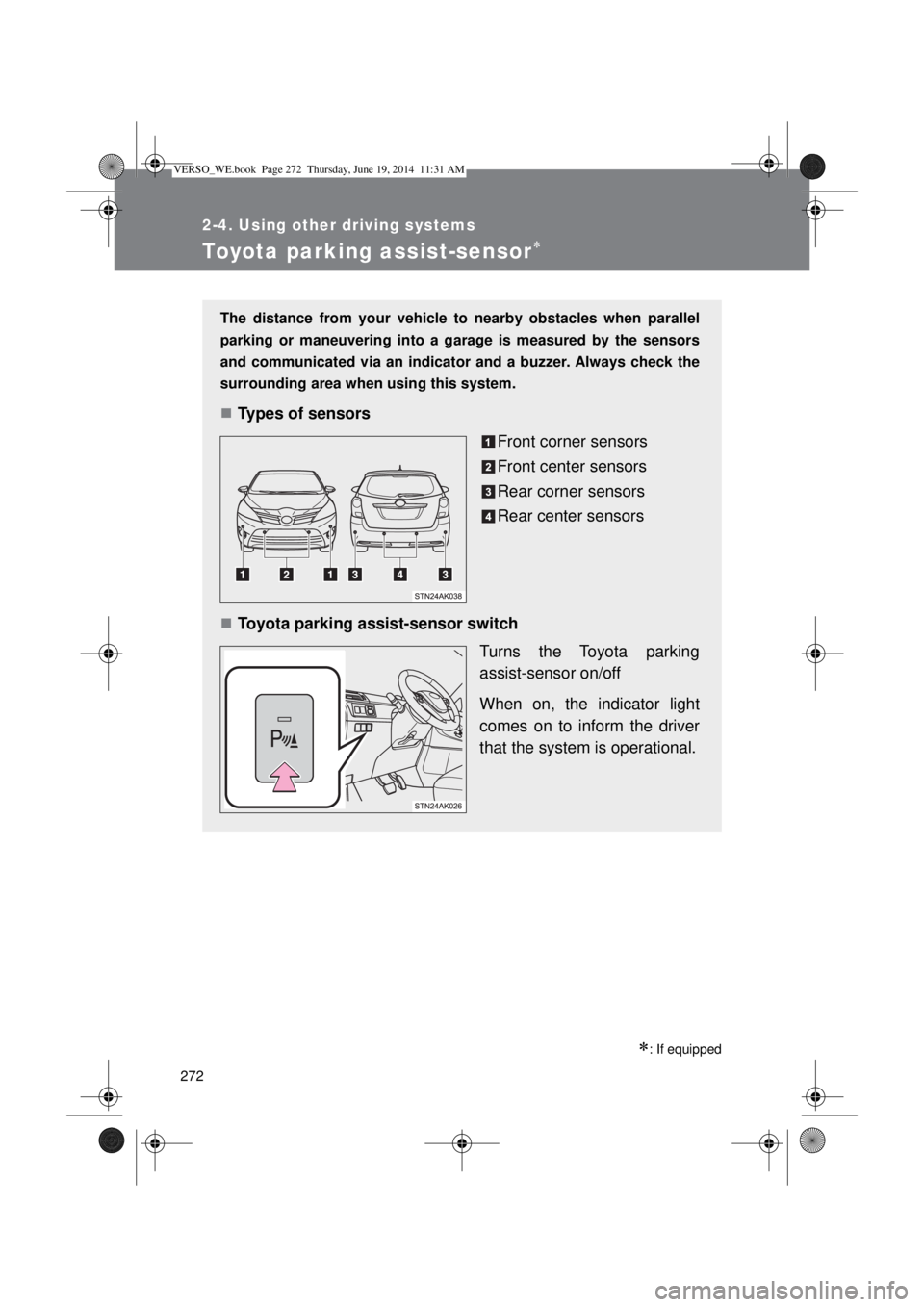
272
2-4. Using other driving systems
Toyota parking assist-sensor
: If equipped
The distance from your vehicle to nearby obstacles when parallel
parking or maneuvering into a garage is measured by the sensors
and communicated via an indicator and a buzzer. Always check the
surrounding area when using this system.
Types of sensors
Front corner sensors
Front center sensors
Rear corner sensors
Rear center sensors
Toyota parking assist-sensor switch
Turns the Toyota parking
assist-sensor on/off
When on, the indicator light
comes on to inform the driver
that the system is operational.
VERSO_WE.book Page 272 Thursday, June 19, 2014 11:31 AM
Page 273 of 650

273 2-4. Using other driving systems
2
When driving
Display
When the sensors detect an obstacle, the Toyota parking assist-sen-
sor indicator is illuminated by an LED depending on position and dis-
tance to the obstacle.
Front center sensor operation
Front corner sensor operation
Rear corner sensor operation
Rear center sensor operation
The light comes on to indicate
that the system is operating
The distance display and buzzer
When a sensor detects an obstacle, the direction of and the approxi-
mate distance to the obstacle are displayed and the buzzer sounds.
Sensor operation and distance to an obstacle
The system operates when the vehicle approaches an obstacle, as
shown by the following table.
VERSO_WE.book Page 273 Thursday, June 19, 2014 11:31 AM
Page 274 of 650
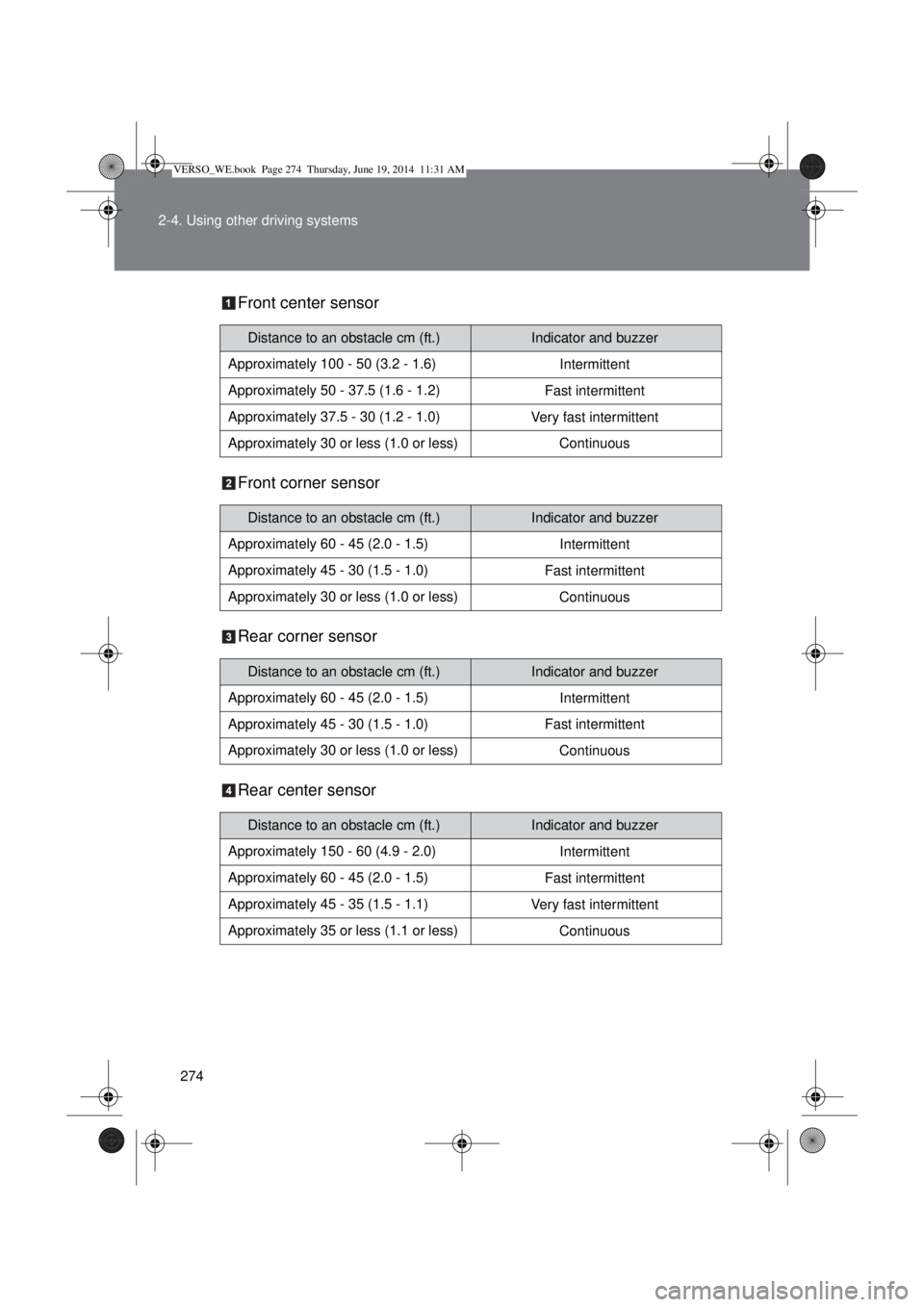
274 2-4. Using other driving systems
Front center sensor
Front corner sensor
Rear corner sensor
Rear center sensor
Distance to an obstacle cm (ft.)Indicator and buzzer
Approximately 100 - 50 (3.2 - 1.6)
Intermittent
Approximately 50 - 37.5 (1.6 - 1.2)
Fast intermittent
Approximately 37.5 - 30 (1.2 - 1.0)
Very fast intermittent
Approximately 30 or less (1.0 or less)
Continuous
Distance to an obstacle cm (ft.)Indicator and buzzer
Approximately 60 - 45 (2.0 - 1.5)
Intermittent
Approximately 45 - 30 (1.5 - 1.0)
Fast intermittent
Approximately 30 or less (1.0 or less)
Continuous
Distance to an obstacle cm (ft.)Indicator and buzzer
Approximately 60 - 45 (2.0 - 1.5)
Intermittent
Approximately 45 - 30 (1.5 - 1.0)
Fast intermittent
Approximately 30 or less (1.0 or less)
Continuous
Distance to an obstacle cm (ft.)Indicator and buzzer
Approximately 150 - 60 (4.9 - 2.0)
Intermittent
Approximately 60 - 45 (2.0 - 1.5)
Fast intermittent
Approximately 45 - 35 (1.5 - 1.1)
Very fast intermittent
Approximately 35 or less (1.1 or less)
Continuous
VERSO_WE.book Page 274 Thursday, June 19, 2014 11:31 AM
Page 275 of 650
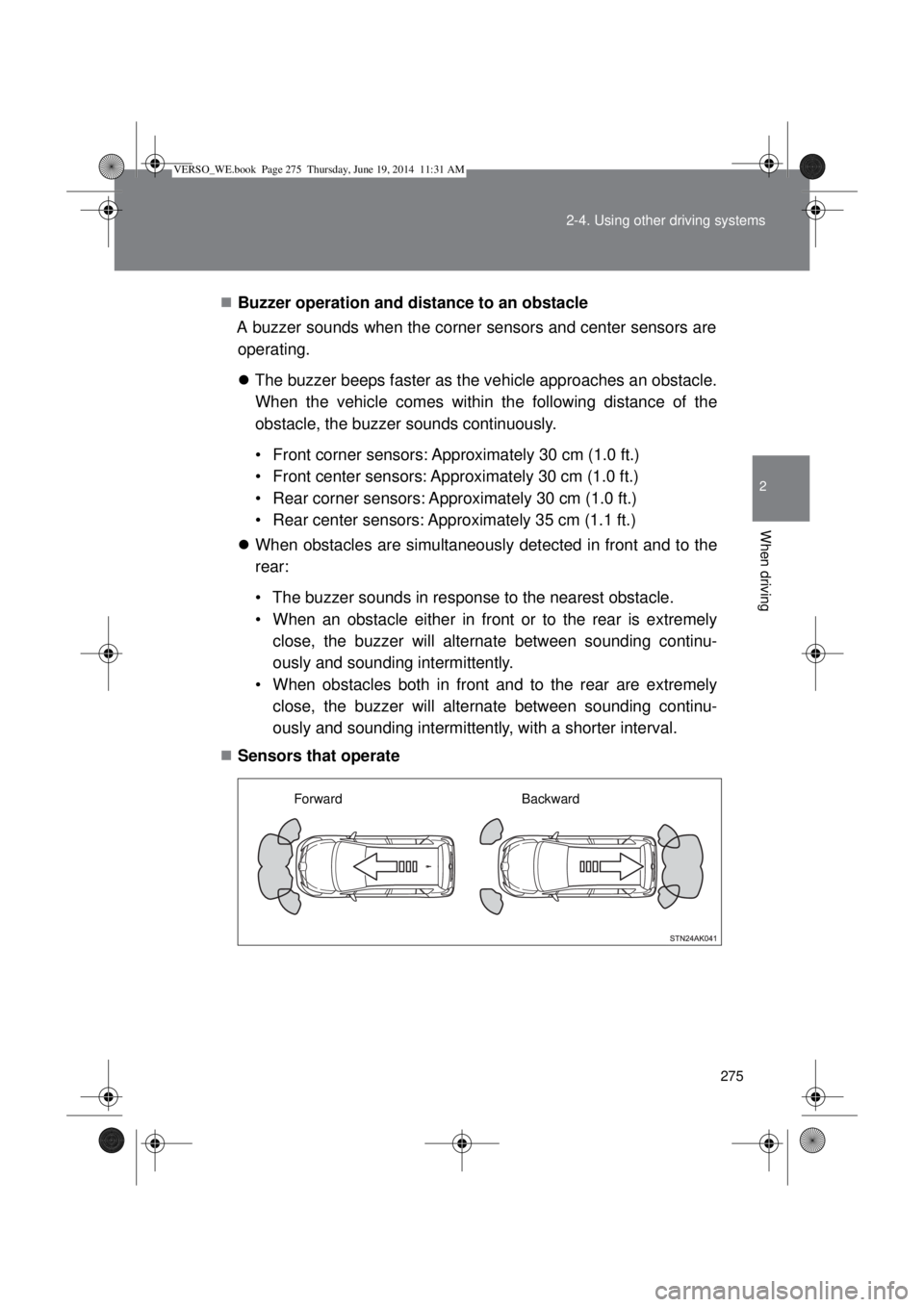
275 2-4. Using other driving systems
2
When driving
Buzzer operation and distance to an obstacle
A buzzer sounds when the corner sensors and center sensors are
operating.
The buzzer beeps faster as the vehicle approaches an obstacle.
When the vehicle comes within the following distance of the
obstacle, the buzzer sounds continuously.
• Front corner sensors: Approximately 30 cm (1.0 ft.)
• Front center sensors: Approximately 30 cm (1.0 ft.)
• Rear corner sensors: Approximately 30 cm (1.0 ft.)
• Rear center sensors: Approximately 35 cm (1.1 ft.)
When obstacles are simultaneously detected in front and to the
rear:
• The buzzer sounds in response to the nearest obstacle.
• When an obstacle either in front or to the rear is extremely
close, the buzzer will alternate between sounding continu-
ously and sounding intermittently.
• When obstacles both in front and to the rear are extremely
close, the buzzer will alternate between sounding continu-
ously and sounding intermittently, with a shorter interval.
Sensors that operate
Forward Backward
VERSO_WE.book Page 275 Thursday, June 19, 2014 11:31 AM
Page 276 of 650
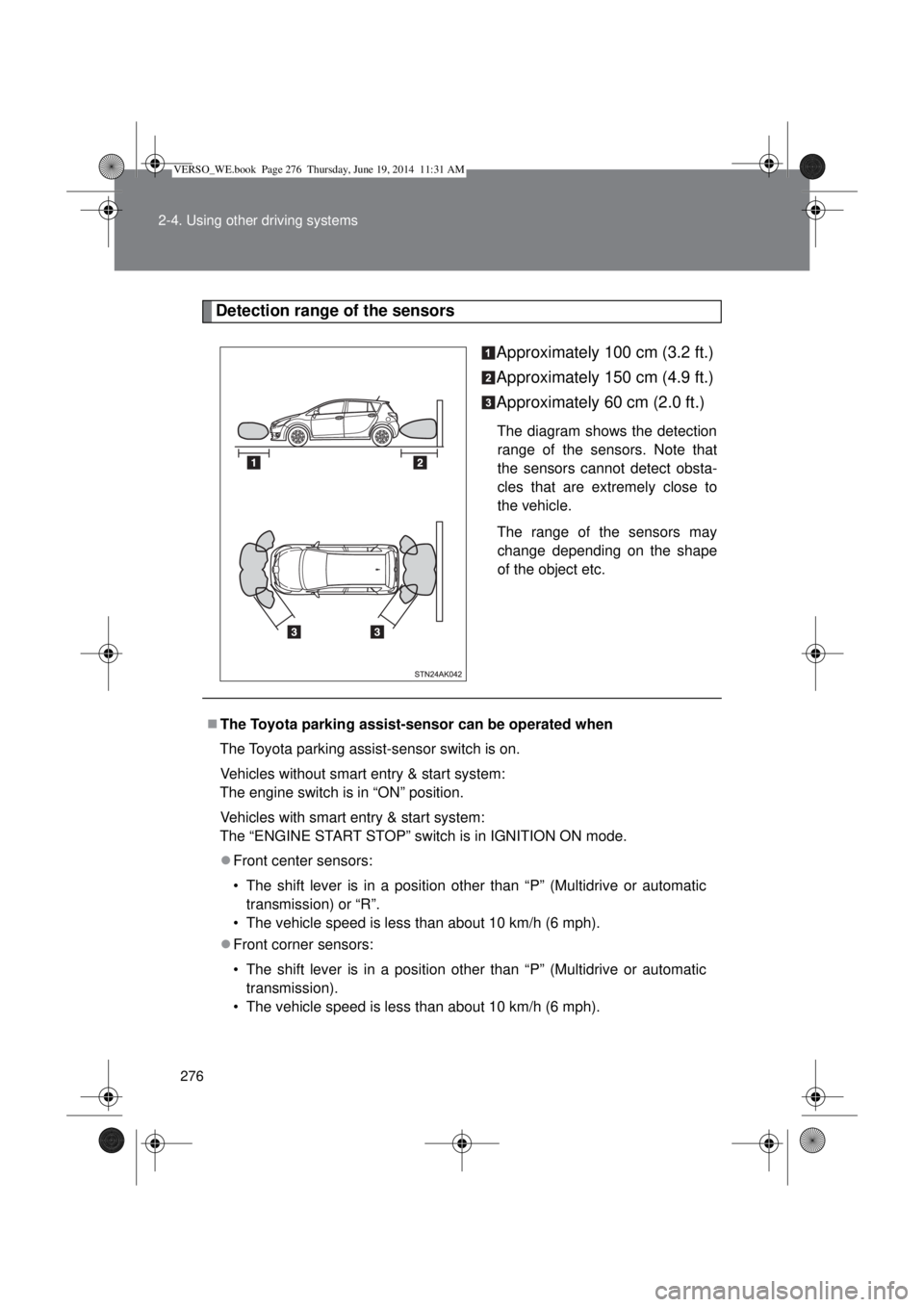
276 2-4. Using other driving systems
Detection range of the sensors
Approximately 100 cm (3.2 ft.)
Approximately 150 cm (4.9 ft.)
Approximately 60 cm (2.0 ft.)
The diagram shows the detection
range of the sensors. Note that
the sensors cannot detect obsta-
cles that are extremely close to
the vehicle.
The range of the sensors may
change depending on the shape
of the object etc.
The Toyota parking assist-sensor can be operated when
The Toyota parking assist-sensor switch is on.
Vehicles without smart entry & start system:
The engine switch is in “ON” position.
Vehicles with smart entry & start system:
The “ENGINE START STOP” switch is in IGNITION ON mode.
Front center sensors:
• The shift lever is in a position other than “P” (Multidrive or automatic
transmission) or “R”.
• The vehicle speed is less than about 10 km/h (6 mph).
Front corner sensors:
• The shift lever is in a position other than “P” (Multidrive or automatic
transmission).
• The vehicle speed is less than about 10 km/h (6 mph).
VERSO_WE.book Page 276 Thursday, June 19, 2014 11:31 AM
Page 277 of 650
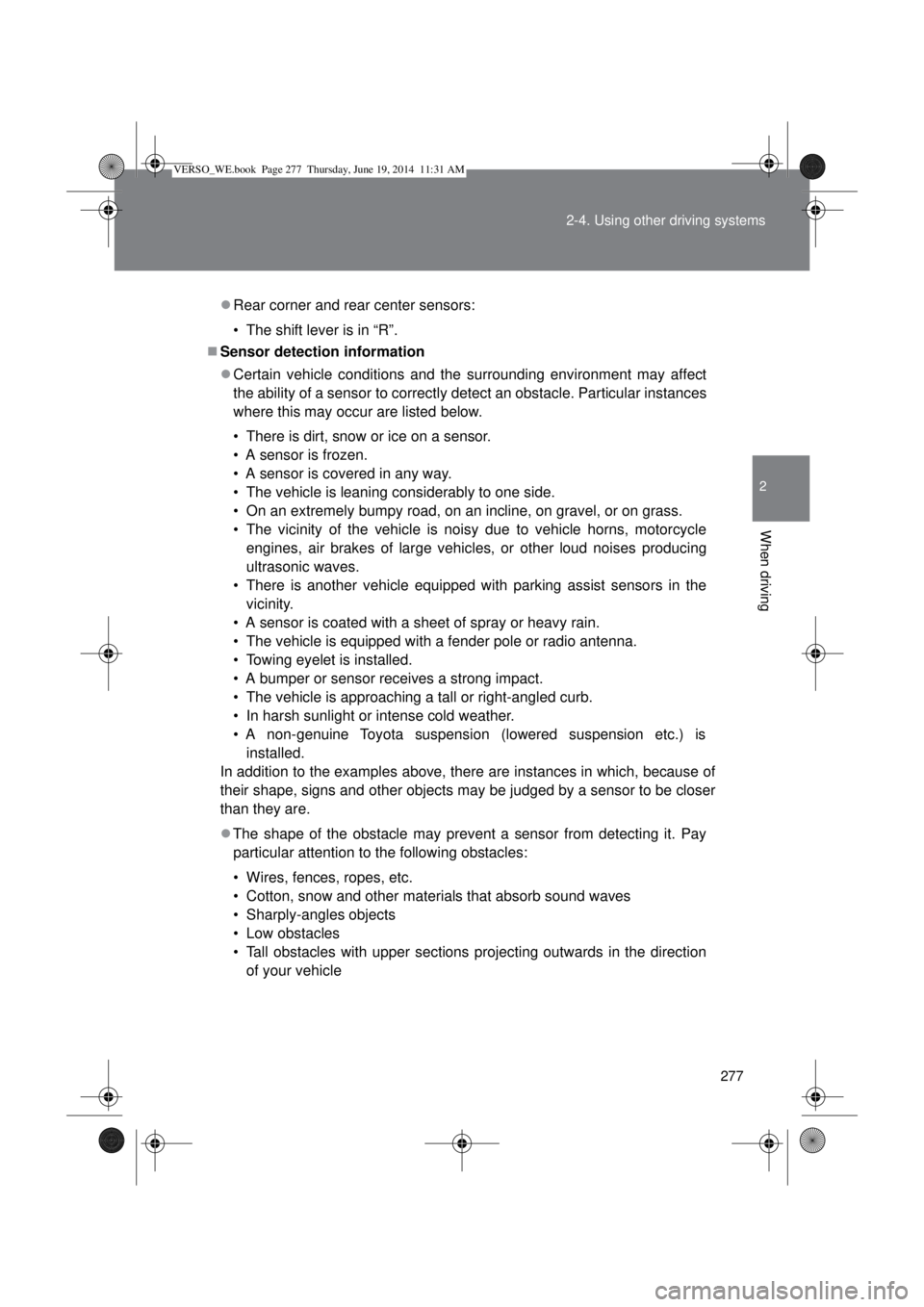
277 2-4. Using other driving systems
2
When driving
Rear corner and rear center sensors:
• The shift lever is in “R”.
Sensor detection information
Certain vehicle conditions and the surrounding environment may affect
the ability of a sensor to correctly detect an obstacle. Particular instances
where this may occur are listed below.
• There is dirt, snow or ice on a sensor.
• A sensor is frozen.
• A sensor is covered in any way.
• The vehicle is leaning considerably to one side.
• On an extremely bumpy road, on an incline, on gravel, or on grass.
• The vicinity of the vehicle is noisy due to vehicle horns, motorcycle
engines, air brakes of large vehicles, or other loud noises producing
ultrasonic waves.
• There is another vehicle equipped with parking assist sensors in the
vicinity.
• A sensor is coated with a sheet of spray or heavy rain.
• The vehicle is equipped with a fender pole or radio antenna.
• Towing eyelet is installed.
• A bumper or sensor receives a strong impact.
• The vehicle is approaching a tall or right-angled curb.
• In harsh sunlight or intense cold weather.
• A non-genuine Toyota suspension (lowered suspension etc.) is
installed.
In addition to the examples above, there are instances in which, because of
their shape, signs and other objects may be judged by a sensor to be closer
than they are.
The shape of the obstacle may prevent a sensor from detecting it. Pay
particular attention to the following obstacles:
• Wires, fences, ropes, etc.
• Cotton, snow and other materials that absorb sound waves
• Sharply-angles objects
• Low obstacles
• Tall obstacles with upper sections projecting outwards in the direction
of your vehicle
VERSO_WE.book Page 277 Thursday, June 19, 2014 11:31 AM
Page 278 of 650

278 2-4. Using other driving systems
When the sensor acts abnormal or malfunctions
Customization that can be configured at any authorized Toyota dealer
or repairer, or another duly qualified and equipped professional
Setting of buzzer volume can be changed.
(Customizable featuresP. 629)
CAUTION
Caution when using the Toyota parking assist-sensor
Observe the following precautions.
Failing to do so may result in the vehicle being unable to be driven safely
and possibly cause an accident.
Do not use the sensor at speeds in excess of 10 km/h (6 mph).
Do not attach any accessories within the sensor range.
When any of the sensors become dirty
or frozen, the abnormal sensor indica-
tor comes on and the buzzer sounds for
8 seconds. After sounding, all of the
sensor indicators will come on.
Clean the sensors with soft cloth.
When any of the sensors malfunction,
the malfunctioning sensor indicator
flashes and the buzzer will sound for 8
seconds. After sounding, all of the sen-
sor indicators will flash.
Have the vehicle inspected by any
authorized Toyota dealer or repairer,
or another duly qualified and
equipped professional. Sensor indicators
VERSO_WE.book Page 278 Thursday, June 19, 2014 11:31 AM
Page 279 of 650

279 2-4. Using other driving systems
2
When driving
NOTICE
Notes when washing the vehicle
Do not apply intensive bursts of water or steam to the sensor area.
Doing so may result in the sensor malfunctioning.
VERSO_WE.book Page 279 Thursday, June 19, 2014 11:31 AM
Page 403 of 650
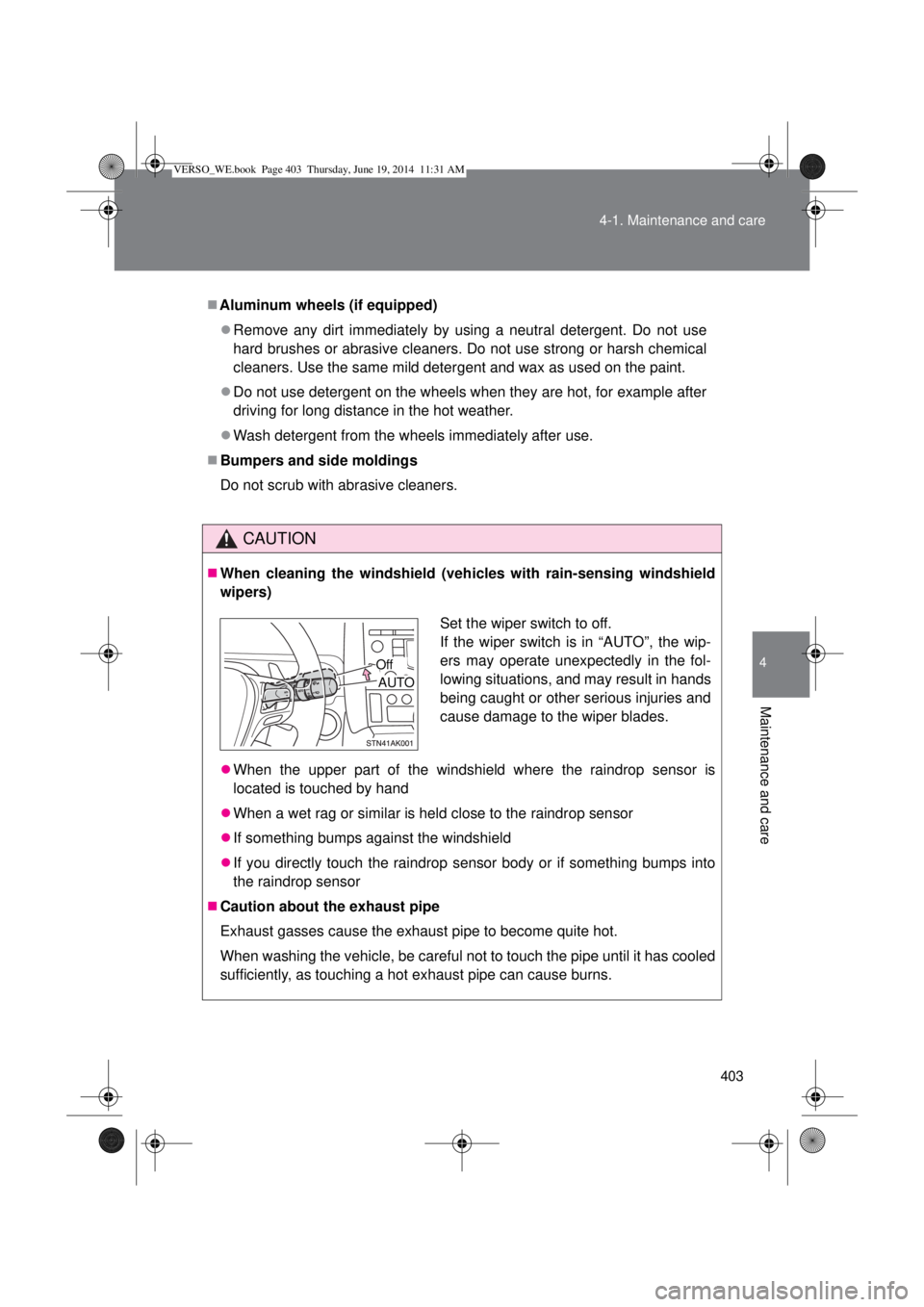
403 4-1. Maintenance and care
4
Maintenance and care
Aluminum wheels (if equipped)
Remove any dirt immediately by using a neutral detergent. Do not use
hard brushes or abrasive cleaners. Do not use strong or harsh chemical
cleaners. Use the same mild detergent and wax as used on the paint.
Do not use detergent on the wheels when they are hot, for example after
driving for long distance in the hot weather.
Wash detergent from the wheels immediately after use.
Bumpers and side moldings
Do not scrub with abrasive cleaners.
CAUTION
When cleaning the windshield (vehicles with rain-sensing windshield
wipers)
When the upper part of the windshield where the raindrop sensor is
located is touched by hand
When a wet rag or similar is held close to the raindrop sensor
If something bumps against the windshield
If you directly touch the raindrop sensor body or if something bumps into
the raindrop sensor
Caution about the exhaust pipe
Exhaust gasses cause the exhaust pipe to become quite hot.
When washing the vehicle, be careful not to touch the pipe until it has cooled
sufficiently, as touching a hot exhaust pipe can cause burns.
Set the wiper switch to off.
If the wiper switch is in “AUTO”, the wip-
ers may operate unexpectedly in the fol-
lowing situations, and may result in hands
being caught or other serious injuries and
cause damage to the wiper blades.
AUTO
Off
VERSO_WE.book Page 403 Thursday, June 19, 2014 11:31 AM